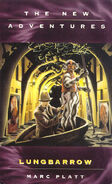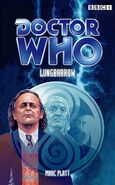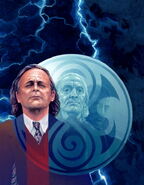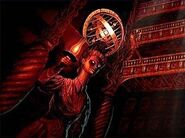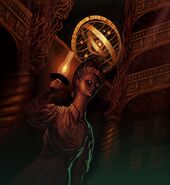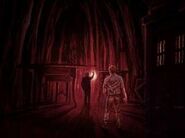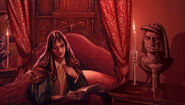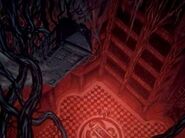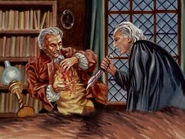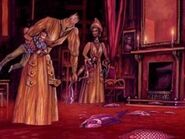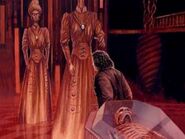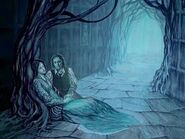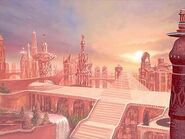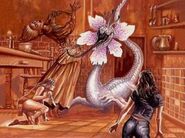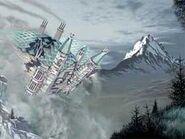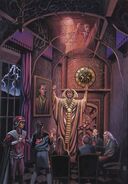- You may be looking for House of Lungbarrow.
Lungbarrow was an original Doctor Who novel written by Marc Platt. Published in Virgin Books' New Adventures range, it was the last of that range to feature the Seventh Doctor.
It is considered the final novel under any banner to feature the Seventh Doctor as the "current" Doctor, although McGann's Eighth Doctor had already made his televised appearance by the time the novel was published. Due to a publication delay, however, an earlier-commissioned novel, So Vile a Sin, also featuring the Seventh Doctor, was published later (although it takes place earlier than Lungbarrow in continuity). One additional Eighth Doctor novel would be published under the Virgin New Adventures banner before the series was handed over to Bernice Summerfield.
Publisher's summary
"Nonsense, child", retorted the Doctor. "Grandfather indeed! I've never seen you before in my life!"
All is not well on Gallifrey. Chris Cwej is having someone else's nightmares. Ace is talking to herself. So is K9. Leela has stumbled on a murderous family conspiracy. And the beleaguered Lady President, Romanadvoratrelundar, foresees one of the most tumultuous events in her planet's history.
At the root of all is an ancient and terrible place, the House of Lungbarrow in the southern mountains of Gallifrey. Something momentous is happening there. But the House has inexplicably gone missing.
673 years ago the Doctor left his family in that forgotten House. Abandoned, disgraced and resentful, they have waited. And now he's home at last.
In this, the Seventh Doctor's final New Adventure, he faces a threat that could uncover the greatest secret of them all.
Plot
to be added
Characters
- Seventh Doctor
- Chris Cwej
- Ace
- Leelandredloomsagwinaechegesima (aka Leela)
- Castellan Andred
- President Romana
- K9 Mark I
- K9 Mark II
- Rodan
- Lord Ferain
- Badger
Flashback / In-memory characters
Other Time Lords
The Doctor's cousins
- Innocet
- Satthralope
- Jobiska
- Rynde
- Arkhew
- Maljamin
- Farg
- Celesia
- Almund
- DeRoosifa
- Chovor
- Salpash
- Luton
- Owis
- Quencessetianobayolocaturgrathageyyilungbarrowmas (aka Quences)
- Glospinninymoras (aka Glospin)
References
Books
- Lord Ferain kept a book called An Alternative History of Skaro: The Daleks without Davros.
- The books The Triumphs of Rassilon, The Book of Rassilon and The Record of Rassilon are books that contain interpretations of Rassilon, Omega and the Other.
The Doctor
- Before leaving Gallifrey the Doctor worked in the Bureau of Possible Events as a Scrutationary Archivist.
- He left his post in the Prydonian Chapterhouse's Bureau of Possibility "after disagreements about his overzealous political involvements".
- The Doctor departs Gallifrey on a final mission to Skaro, as requested by Romana II.
- When he was leaving Gallifrey, the Doctor nearly stole a Type 53, but dismissed this TARDIS as "new fangled" and went with his Type 40.
Gallifreyan culture
- Sepulchasm is a Time Lord game, and quite possibly a profanity.
- The play Mystery of the New Time is usually conducted during Otherstide.
Gallifreyan lifeforms
- Gallifreyan forests have striped pig-bears in them.
Gallifreyan locations
- The Doctor returns to his house, the House of Lungbarrow.
Gallifreyan technology
- Looms create new Gallifreyans.
- The Hand of Omega befriended the Doctor because it sensed the Other's essence in him.
- The Time Vortex is red when travelling forward in time and blue when travelling backwards.
Gallifreyan organisations
- The CIA kill Ace for twenty minutes and upload her memories to the Matrix.
- An organisation called Space-Time Accessions Bureau exists.
- The Ordinal-General does not allow members of the House of Redlooms into the Bureau of Temporal Anomalies.
Individual Gallifreyans
- Andred belongs to the House of Redlooms.
- Susan's mother died as Pythia cursed Gallifrey.
- Susan's nanny was called Mamlaurea.
- Pythia threw herself into the Crevice of Memories That Will Be.
- Omega was lost in the constellation of Ao.
Plants
- Leela still carried janis thorns.
Planets
Species
- President Romana is successfully negotiating with the Tharils.
- Romana did not attend the reception for the Chelonian envoy.
- Fledershrews are present in the House of Lungbarrow.
Relatives of the Doctor
- Innocet has telekinesis and telepathy.
Notes
- Lungbarrow wrapped up the last of the continuity of the New Adventures and put the Doctor on course to gather the Bruce Master's remains from Skaro, as depicted in the 1996 Doctor Who television movie. It is also one of a number of the New Adventures which is hard to obtain and is often seen on auction websites such as eBay at prices many times the original cover price.
- Before losing their license to BBC Books, it had been announced that the Seventh Doctor's adventures would have continued in periodic Missing Adventures releases, with the Eighth Doctor taking over the NA line. Ultimately, only one Eighth Doctor novel was published and the MA line came to an end before any Seventh Doctor releases could occur. Future Seventh Doctor novels would be released under the BBC Past Doctor Adventures line.
- The Seventh Doctor's last words in the Virgin New Adventures series are; "Dorothee! I just remembered. I haven't been Merlin yet!"
- The novel which followed Lungbarrow, Lance Parkin's The Dying Days, featured the Eighth Doctor. When Virgin subsequently lost their license to print original Doctor Who fiction, they chose to focus on a character from the New Adventures which the BBC did not own, former companion Bernice Summerfield. Lungbarrow serves, in concert with Dying Days, to gradually increase the standing of Summerfield's character, laying the groundwork for the later appearance of the Seventh Doctor's then-companion, Chris Cwej, in Summerfield's own novels.
- This novel, however, was largely concerned with concluding what was known as the "Cartmel Masterplan". In the final two seasons of the original 1963-1989 run of Doctor Who, the then script editor Andrew Cartmel introduced new elements of mystery into the character of the Doctor. Suggestions of dark secrets that the Doctor might be more than just a Time Lord were inserted into scripts of stories such as Ben Aaronovitch's Remembrance of the Daleks and Kevin Clarke's Silver Nemesis. Had the series not been effectively cancelled in 1989, the following season would have made some of these revelations. Elements of Platt's planned Lungbarrow instead became part of the Season 26 serial Ghost Light.
- Along the way to this resolution, Lungbarrow ultimately reveals much new information about the Doctor's home world and race, some of which had been hinted at ever since the first New Adventures novel. Many of the New Adventures authors migrated to the BBC Books Doctor Who line and elements of this backstory also made their way into subsequent novels. However, there have also been elements in those novels that contradict it.
- The claim that Time Lords are born fully mature, never having a physical childhood, has been contradicted by several pieces of media.
- In the television story The Time Monster, the Third Doctor tells Jo Grant a story regarding when he was a "little boy".
- In the television story The Sound of Drums, the Master is shown as a child in a Time Lord ritual. The Tenth Doctor specifically mentions that before this ritual "[the c]hildren of Gallifrey [were] taken from their families [at the] age of eight to enter the Academy". The television story The End of Time reuses footage from Drums while the Master's childhood is discussed. In The End of Time, the Chancellor refers to the "simple task" of the four beats of a Time Lord's heartbeat being transmitted back in time and implanted into "the Master's mind as a child".
- The Eleventh Doctor has a cot, seen in the television story A Good Man Goes to War, which he claims to have once slept in, and his original incarnation is shown as a young boy in the television story Listen, in which he is described by a Gallifreyan man as "that boy".
- In the television story The Girl in the Fireplace, Reinette describes the Doctor as having a "lonely childhood" and being "[s]uch a lonely little boy" while she looks inside the Tenth Doctor's mind. In TV: The Empty Child, the Ninth Doctor himself similarly remarks that he knows what it's like to be the "only child left out in the cold".
- The Ninth Doctor agrees with Doctor Constantine's remark of being a "father and grandfather" in the television story The Empty Child, the Tenth Doctor recounts being "a dad" or "a father" in the television story Fear Her and The Doctor's Daughter and his twelfth incarnation mentions his "dad skills" in Listen. In the television story The Witch's Familiar, Missy mentions a daughter from "the olden days on Gallifrey". In the television story Hell Bent, the Twelfth Doctor mentions how the Doctor "stole" the moon and the President's wife, before correcting himself to say that was a lie from the Shobogans, and she was actually the President's daughter, and the moon was lost.
- The television movie Doctor Who has the Eighth Doctor remember being with his father and The End of Time also has the Saxon Master asking the Tenth Doctor if he remembered the land on the slopes of Mount Perdition the Master's father owned.
- In the television story Death in Heaven, the Twelfth Doctor recalls running together with the Master when the Doctor was "little".
- In the television story Heaven Sent, the Twelfth Doctor recounts a memory from when he was a "very little boy" about a woman who resembled the Veil, which gave him nightmares for years.
- The Timeless Children depicts the Doctor's hidden and forgotten life as a young girl taken in by the Gallifreyan people, showcasing multiple regenerations as children.
- A second edition of Lungbarrow, featuring both additions to and subtractions from the original text made by the author and accompanied by author's notes and new illustrations by Daryl Joyce, was released by BBCi as an e-book on the official Doctor Who website on 22 August 2003. It became inaccessible in 2010.
- The Houses of Gallifrey are similar to the household featured in Peake's Gormenghast trilogy. Badger, a character who makes his first appearance in Lungbarrow, has much in common with a character in Peake's Gormenghast novella, Boy in Darkness, which originally appeared in the collected work Sometime, Never by Golding, Wyndham and Peake. [1]
- Lance Parkin on an Outpost Gallifrey forum thread [2] stated in 2005 that the reason the last three books in the Virgin New Adventures range, including Lungbarrow, were so expensive on the secondary market was excessive demand, rather than an unusually low initial print run. However, he also noted that reprints of these books were not allowed, because Virgin's license expired before a second printing might otherwise have been made.
- The numbering of this book as 60 of 61 refers to the publisher's intended order, which ultimately was not the actual order of publication. Because of chronic delays troubling Ben Aaronovitch's So Vile a Sin, eventually finished by Kate Orman, it was actually the 59th New Adventure published.
Continuity
- The hermit that lived on the mountain near the Doctor's home was first mentioned in TV: The Time Monster, and later featured in TV: Planet of the Spiders.
- The Sisterhood of Karn first appeared in TV: The Brain of Morbius. They would later be responsible for the Eighth Doctor's regeneration. (TV: The Night of the Doctor)
- Leela met Andred in TV: The Invasion of Time.
- Romana returned from E-Space in PROSE: Blood Harvest, and became president in PROSE: Happy Endings.
- A lot of Gallifreyan history revisited in this novel first appeared in PROSE: Cat's Cradle: Time's Crucible.
- Romana gives the Doctor her sonic screwdriver. (TV: The Horns of Nimon)
- The Doctor used the Hand of Omega in TV: Remembrance of the Daleks.
- Romana started negotiations with the Daleks, giving the Master to them under the Act of Master Restitution. (PROSE: A Brief History of Time Lords)
- The Doctor goes on one final mission to pick up the Master's remains, leading into TV: Doctor Who.
- Gallifrey's renewed ties with the Sisterhood of Karn abolishes Pythia's curse of sterility upon the population. (TV: The Day of the Doctor)
- Innocet tells Chris Cwej that the Houses are the oldest living things on Gallifrey, the first ones having been grown during the Intuitive Revelation. (PROSE: Cat's Cradle: Time's Crucible)
- PROSE: Unnatural History explains that PROSE: The Eight Doctors is a result of Rassilon's disgusted response to the Time Lords' reconciliation with the Sisterhood and the lifting of Pythia's curse.
- During the confrontation between Rassilon and the Other, it is mentioned that the Looms give the new generations of Gallifreyans the ability to regenerate; Rassilon and the Other cannot do so. This contradicts the suggestion in PROSE: Cold Fusion that the "Morbius Doctors" were the Other's faces, and PROSE: The Multi-Faceted War, where Rassilon is said to have regenerated.
Illustrations
The e-book version published by the BBC on their website included a new cover and seventeen additional illustrations by Daryl Joyce, some with multiple versions. Titles of illustrations are as they were on BBC's site.[3] Daryl Joyce remade the chapter 22 image in 2012.[4]
External links
- Lungbarrow at the Doctor Who Reference Guide
- Lungbarrow at the Faction Paradox wiki
- The Discontinuity Guide to: Lungbarrow at The Whoniverse
- The Cloister Library: Lungbarrow

